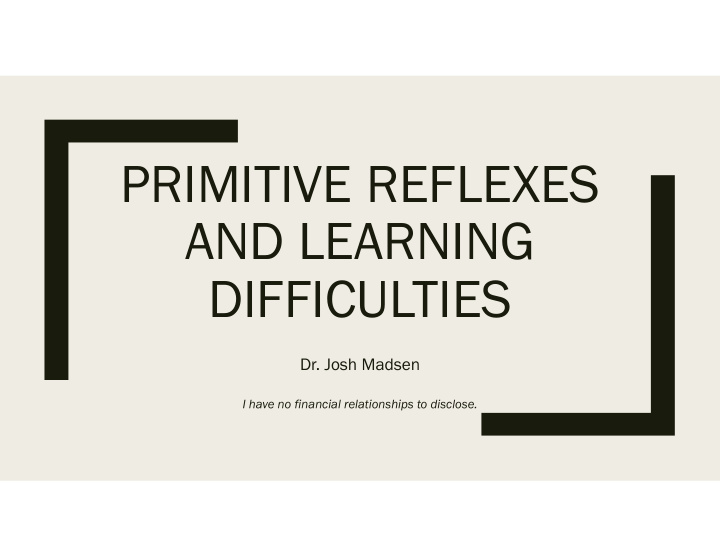



PRIMITIVE REFLEXES AND LEARNING DIFFICULTIES Dr. Josh Madsen I have no financial relationships to disclose.
PRIMITIVE REFLEX INTEGRATION SCHEDULE
Asymmetrical Tonic Neck Reflex (ATNR)- develops around 6 months
ATNR
ATNR- What does this reflex do? ■ In my eyes it is the most important reflex in development, and the most common area of underdevelopment! ■ It helps us develop appropriate muscle tone ■ Develop hand eye coordination ■ Develop balance ■ Develop eye tracking abilities from side to side ■ Helps us develop the ability to cross midline ■ Also helps us get out of the womb ■ Helps us develop army crawling, cross crawling, and walking ■ Helps us to develop proper ROM in cervical spine- results in torticollis, feeding issues, rolling delay, crawling delays, walking difficulties if not developed well.
Symmetrical Tonic Neck Reflex (9-11 months)
The STNR helps baby lift and control the head for far-distance focusing. It preps the infant for crawling. This reflex helps to link the upper and lower extremity to move reflexively. STNR- What does it do? Common sym Common symptoms ms Vision disorders (convergence Squirming or moving, insufficiency and Headaches from Difficulties with poor posture, muscle tension reading and writing saccadic eye slouching movements in vertical plane)
MORO REFLEX- Develops in the womb and gets inhibited by 2-4 months
What is the purpose of the MORO Reflex? ■ This reflex is an automatic reaction to sudden changes in head position, light, sound, touch or temperature. It creates an instant arousal of the baby’s survival system, or an automatic fight or flight response. When this reflex is elicited the infant: ■ 1. Releases stress hormones- ADRENALINE and CORTISOL ■ 2. Increases breathing rate ■ 3. Increases heart rate and blood pressure.
If the MORO Reflex does not integrate and get inhibited at the appropriate time what are common symptoms? ■ Sleep disturbances Weak immune system Asthma, allergies and infections ■ Difficulty settling to sleep Hypersensitivity to light, movement, ■ Easily triggered anger or sound, touch and smell emotional outbursts Difficulties with vision, reading or ■ Shyness writing Difficulty adapting to change ■ Poor balance and coordination Cycles of hyperactivity and extreme fatigue ■ Poor stamina Easily distracted ■ Motion sickness Difficulty with visual perception Easily ■ Poor digestion fatigued
Case Case This young lady presented with: 1. Chronic anxiety 2. Motion sickness if she rode in a care longer than 5 minutes 3. Vision disorders (convergence insufficiency, saccadic eye movements) After one month of care: 1. No more anxiety 2. Can ride in a car 2 hours 3. Graduated from vision therapy What we did: Adjusted her, worked on a MORO reflex, ATNR, STNR. Removed gluten from her diet.
Resources and references for you to learn more. Reflexes, Learning and Behavior: A Window Into a Child’s Mind. A non- invasive approach to solving learning and behavioral problems . – Sally Goddard Neurobehavioral Disorders of Childhood by Dr. Robert Melillo and Dr. Gerry Leisman Neuromotor Immaturity in Children and Adults- Sally Goddard All of Sally Goddard’s books are great for learning about primitive reflexes Interdisciplinary Association of Functional Neurology and Rehabilitation- International Childhood Neurodevelopmental Disorders Certification Course- taught by Dr. Melillo and is a wonderful course to learn about brain asymmetries and abnormal development.
Recommend
More recommend